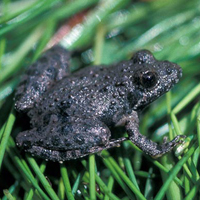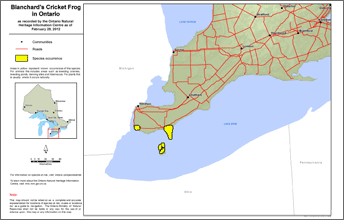Blanchard’s Cricket Frog
Scientific name: Acris blanchardi

Cover photo credit: Michael Oldham
Status
Extirpated
“Extirpated” means the species lives somewhere in the world, and at one time lived in the wild in Ontario, but no longer lives in the wild in Ontario.
Date added to the Species at Risk in Ontario List
January 13, 2008.
Read the assessment report.
What it looks like
The Blanchard’s Cricket Frog is a small, semi-aquatic frog with rough warty skin and a pointed snout. Adults rarely reach more than 38 millimetres in length. They are brown or grey and have a V-shaped mark between the eyes and a jagged dark stripe on their back legs. The Blanchard’s Cricket Frog’s call resembles the sound of two pebbles being clicked together.
Where it lives
The Blanchard’s Cricket Frog prefers habitat around the edges of lakes, ponds, rivers, and streams with dense aquatic vegetation and muddy shorelines. On Pelee Island, they have even been found in ditches, flooded fields and drainage canals used for agriculture. Blanchard’s Cricket Frogs hibernate away from the water under rocks or logs, or in holes and cracks in the shoreline.
Where it’s been found in Ontario
In Canada, the Blanchard’s Cricket Frog was found only on Pelee Island and Point Pelee in southwestern Ontario.
This subspecies has a widespread distribution in the United States ranging from Minnesota and Wisconsin, east to Illinois, Indiana, Michgan and Ohio, and south to Kentucky and West Virginia.
View a Larger version of this map (PDF)
Why it disappeared from Ontario
The most significant factor which led to the decline and disappearance of Blanchard’s Cricket Frog is the loss of wetlands due to development. Habitat degradation was also a factor since this frog does not tolerate pollution. Runoff of pesticides and fertilizers is believed to have been a major contributor to the disappearance of this species.
Action we are taking
Extirpated species and their habitat are protected if the species are again found in Ontario.
Help Make Sure We Don’t Lose More Endangered Species in Ontario
- As with all wildlife, be respectful and observe from a distance. Please don’t try to catch wild frogs. Bug repellent and oils on human hands may damage the delicate skin of these little amphibians.
- Every year frogs all over the province must cross busy roads. Road mortality is a serious threat for many of Ontario’s amphibians. Watch for frogs on the roads especially between April and June.
- Report any illegal activity related to plants and wildlife to
1-877-TIP-SMNR (847-7667) . - Private land owners have an important role to play in species recovery. You may be eligible for stewardship programs that support the protection and recovery of species at risk and their habitats.
- Volunteer with a local nature club or provincial park to participate in surveys or stewardship work focused on species at risk.
- Visit the Ontario Reptile and Amphibian Atlas (www.ontarionature.org/atlas) or Toronto Zoo Adopt-a-Pond website (www.torontozoo.com/Adoptapond) to learn more about Ontario’s rare snakes, their habitat and related conservation initiatives.
Quick facts
- Blanchard’s Cricket Frogs are members of the tree frog family, however, they do not live in trees and are more highly aquatic than other North American tree frogs.
- This species is an excellent swimmer and is capable of leaping up to almost two metres in a single jump to escape predators.
- Frogs can take in oxygen through their skin. Their skin can also easily absorb pollutants and other toxins, which can cause serious harm or death.
- Although populations of many plants and animals have been declining worldwide, amphibians are experiencing an especially dramatic decline. The loss of these sensitive creatures may act as a warning that our own environment is being dangerously altered and polluted.
- In Greek, the word "amphibian” means “both + life” and refers to the water tadpole and the land adult stages of all amphibians. Frog tadpoles hatch from eggs laid in the water and transform into adult frogs (through a process called metamorphosis) by developing legs and lungs that allow it to move out of the water and onto land.
